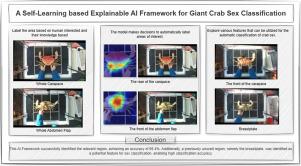A self-learning based explainable AI framework for giant crab sex classification
IF 8.9
1区 农林科学
Q1 AGRICULTURE, MULTIDISCIPLINARY
引用次数: 0
Abstract
Sexual dimorphism is prevalent in crustaceans, and in crabs, it can be observed in body size, carapace shape, and larger and differently shaped claws in males, among other traits. With the advancement of artificial intelligence (AI), automatic sex classification is now possible by leveraging these differential traits between males and females. Traditionally, most research has relied on analysing the entire crab to classify its sex. Subsequently, studies have focused on specific features, such as the abdominal flap or carapace, which facilitate sex differentiation by humans. However, human intervention creates a significant labelling burden and constrains the exploration of other potentially valuable characteristics for research. In this study, a novel framework is introduced for automatic sex classification in crabs. Unlike traditional approaches that rely heavily on manual labelling and predefined features such as abdominal flaps, our framework minimizes human intervention and enables the model to autonomously highlight image regions most informative for classification. This draws attention to underutilized morphological regions that may be useful for sex classification without requiring prior biological knowledge. Furthermore, the framework provides visual explanations of the model’s decisions, enhancing interpretability. Using this approach, we achieved a classification accuracy of 95.4%, while also pinpointing specific regions contributing to the decision-making process.

基于自我学习的可解释的巨蟹性别分类人工智能框架
两性二态性在甲壳类动物中很普遍,在螃蟹中,可以在身体大小、甲壳形状、雄性更大且形状不同的爪子等特征中观察到。随着人工智能(AI)的进步,利用男性和女性之间的这些差异特征,自动性别分类现在成为可能。传统上,大多数研究都依赖于分析整个螃蟹来分类它的性别。随后,研究集中在特定的特征上,如腹部皮瓣或甲壳,它们有助于人类的性别分化。然而,人为干预造成了显著的标签负担,并限制了对其他潜在有价值特征的探索。本研究提出了一种新的蟹类性别自动分类框架。与传统方法严重依赖手动标记和预定义特征(如腹部皮瓣)不同,我们的框架最大限度地减少了人为干预,并使模型能够自主突出图像区域,为分类提供最丰富的信息。这引起了人们对未充分利用的形态学区域的注意,这些区域可能对性别分类有用,而不需要事先的生物学知识。此外,该框架提供了模型决策的可视化解释,增强了可解释性。使用这种方法,我们实现了95.4%的分类准确率,同时还精确定位了有助于决策过程的特定区域。
本文章由计算机程序翻译,如有差异,请以英文原文为准。
求助全文
约1分钟内获得全文
求助全文
来源期刊

Computers and Electronics in Agriculture
工程技术-计算机:跨学科应用
CiteScore
15.30
自引率
14.50%
发文量
800
审稿时长
62 days
期刊介绍:
Computers and Electronics in Agriculture provides international coverage of advancements in computer hardware, software, electronic instrumentation, and control systems applied to agricultural challenges. Encompassing agronomy, horticulture, forestry, aquaculture, and animal farming, the journal publishes original papers, reviews, and applications notes. It explores the use of computers and electronics in plant or animal agricultural production, covering topics like agricultural soils, water, pests, controlled environments, and waste. The scope extends to on-farm post-harvest operations and relevant technologies, including artificial intelligence, sensors, machine vision, robotics, networking, and simulation modeling. Its companion journal, Smart Agricultural Technology, continues the focus on smart applications in production agriculture.
 求助内容:
求助内容: 应助结果提醒方式:
应助结果提醒方式:


